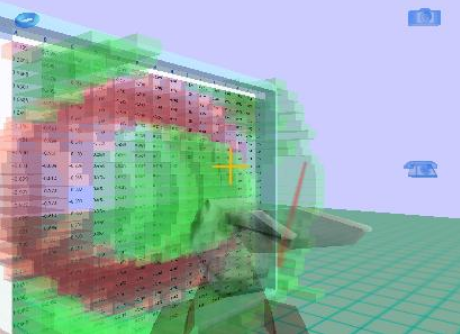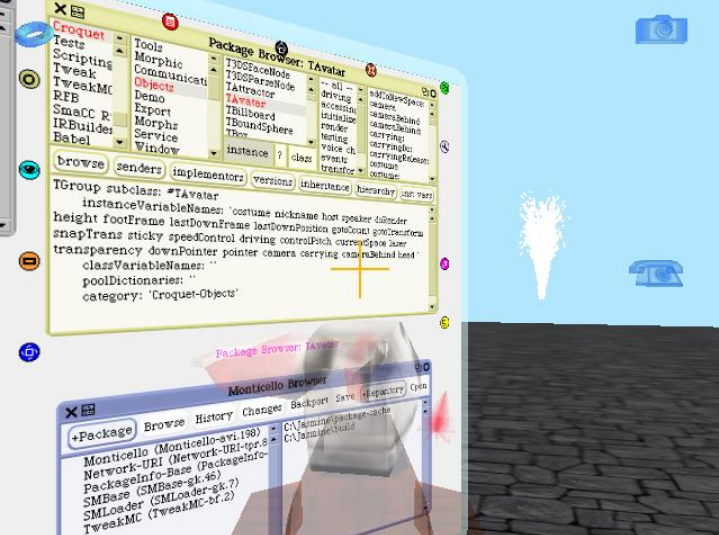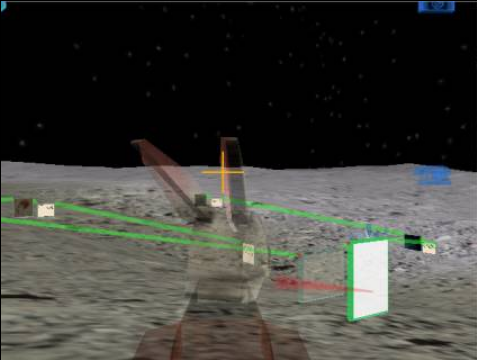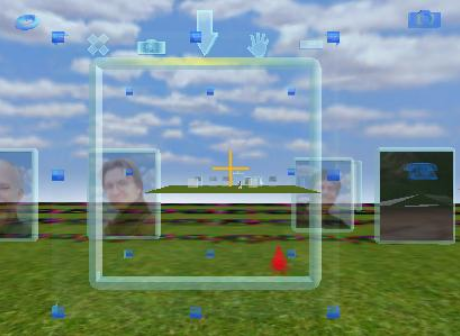-

Editing a spreadsheet in Croquet OS. https://handwiki.org/wiki/index.php?curid=1928362
-

Croquet allows users to edit the source code of the 3D world from within the world, and immediately see the result, while the world is still running. The running program does not need to be ended, and there is no compile-link-run-debug development loop. Any part of the program may be edited, down to the VM and OpenGL calls.
-

Adding 3D Notes linked to 3D objects and places. https://handwiki.org/wiki/index.php?curid=1222927
-

Real time, interactive, 3D map of this very same world. Change something in the world, the map changes. Move something in the map (as one would a chess piece), the object in the world represented by it moves the same way. https://handwiki.org/wiki/index.php?curid=1971640

| Version | Summary | Created by | Modification | Content Size | Created at | Operation |
|---|---|---|---|---|---|---|
| 1 | Dean Liu | -- | 1419 | 2022-10-20 01:44:29 |
Video Upload Options
Croquet OS is a web-based operating system for creating three-dimensional apps with multi-user functionalities that run simultaneously on any device. Croquet can be used for communication, online gaming environments such as massively multiplayer online role-playing games (MMORPGs), 3D wikis, virtual learning and problem solving environments, privately maintained or interconnected multi-user virtual environments, and more advanced functions such as highly scalable collaborative data visualization, resource sharing, and synchronous computation among multiple users.
1. History
The original authors of Croquet opened a commercial company named Qwaq which was later renamed to Teleplace. That technology was later sold back to a group of the original Croquet developers and became Immersive Terf.[1][2]
Croquet is the confluence of several independent lines of work that were being carried out by its six principal architects, Alan Kay, David A. Smith. David P. Reed, Andreas Raab, Julian Lombardi, and Mark McCahill. The present identity of the project has its origins in a conversation between Smith and Kay in 1990, where both expressed their frustration with the state of operating systems at the time.
In 1994, Smith built ICE, a working prototype of a two user collaborative system that was a predecessor of the core of what Croquet is today. Also in 1994 Mark McCahill's team at the University of Minnesota developed GopherVR, a 3D user interface to Internet Gopher to explore how spatial metaphors could be used to organize information and create social spaces. In 1996, Julian Lombardi approached Smith to explore the development of highly extensible collaborative interfaces to the World Wide Web. Later, in 1999, Smith built a system called OpenSpace, which was an early-bound variant of Croquet. Also in 1999, Lombardi began working with Smith on prototype implementations of highly extensible collaborative online environments based on OpenSpace. One of these implementations was a prototype implementation of ViOS, a way to spatially organize all Internet-deliverable resources (including web pages) into a massively-scaled multi-user 3D environment.
Smith and Kay officially started the Croquet Project in late 2001 and were immediately joined by David Reed and Andreas Raab. Reed brought to the project his longstanding work on massively scalable peer-to-peer messaging architectures in a form deriving from his doctoral dissertation that was published in 1978. The first working Croquet code was developed in January 2002. Simultaneously and independently, Lombardi and McCahill began collaborating on defining and implementing highly scalable and enterprise-integrated architectures for multi-user collaboration and were invited by Kay to join the core architectural group in 2003.
From 2003 to 2006, the technology was developed under the leadership of its six principal architects with financial support from Hewlett-Packard, Viewpoints Research Institute Inc., the University of Wisconsin–Madison, University of Minnesota, Japanese National Institute of Communication Technology (NICT), and private individuals. On April 18, 2006 the project released a beta version of the Croquet SDK 1.0 in the open-source. Since then, the Croquet technology infrastructure has been successfully used by private industry to build and to deploy commercial-grade closed source collaborative applications. Open source production-grade software implementations for delivering secure, interactive, persistent, virtual workspaces for education and training have at the same time been developed and deployed at the University of Minnesota, University of Wisconsin–Madison, University of British Columbia, and Duke University.
In May 2018, David A. Smith founded Croquet Corporation. Alan Kay’s team of engineers, Vanessa Freudenberg, Aran Lunzer, Yoshiki Ohshima, as well as Smith’s collaborator from Red Storm Entertainment, Brian Upton, joined Smith as co-founders of Croquet Corporation, to build a software system for creating multi-user digital experiences on the web. Croquet lets developers build real time multi-user apps without writing a single line of server code, or deploying or managing any servers. Croquet consists of a JavaScript library that grants access to its global network of public reflectors.[3]
In 2020, the company raised its first round of funding. The company is based in Los Angeles , California .
2. Features
- It is platform and device independent
- Users and developers may freely share, modify and view the source code of the whole system, due to a liberal license
- The technology is not hosted on one organization's server, and hence not governed by any such organization
- It provides a complete professional programmer's language (Squeak Smalltalk), integrated development environment (IDE), and class library in every distributed, running participant's copy; the programming development environment itself is simultaneously shareable and extensible
- Croquet based worlds can also be updated while the system is live and running
3. Technical Functions
Croquet is a software development kit (SDK) for use in developing collaborative virtual world applications.
Applications created using the Croquet SDK are automatically collaborative since application objects in Croquet share a common protocol allowing them to cooperate with each other by employing the principle of replicated computation (synchronization) together with a peer-based messaging protocol. The technology is designed to facilitate such replication between peers, to greatly reduce the overhead needed for widespread deployment of collaborative virtual worlds.
This efficiency, combined with the ability to deploy Croquet-based virtual worlds on consumer-level hardware, makes it possible for developers to deploy large-scale and highly participatory collaborative worlds at very low cost compared with virtual world technologies that are entirely dependent on server-based infrastructures to support the activities of their users.
3.1. Virtual Machine
Croquet's virtual machine (VM) runs bit identically on multiple platforms, and supports multiple abilities that could only be provided by a true late bound, message sending language.
Croquet's relationship to Squeak gives Croquet the property of a purely object-oriented system allowing for significant flexibility in the design and the nature of the protocols and architectures that have been developed for the system.
Because of this, Croquet has the ability to keep running while code is modified and tested, while changes are made, an essential part of the Croquet collaborative development ability. Users can change the code running the environment while the environment runs.
Synchronization architecture
Croquet's time-based synchronization abilities enable real-time, identical interactions between groups of users while dramatically reducing the need for server infrastructures to support virtual world deployment. Croquet's architecture makes it easy to develop deeply collaborative applications without having to spend a lot of effort and expertise in understanding how replicated applications work.
TeaTime is a scalable real-time multi-user architecture that is the basis for Croquet's object-object communication and synchronization. It is designed to support multi-user applications that can be scaled to massive numbers of concurrently interacting users in a shared virtual space. The most directly visible part of this architecture is the TObject class which is used to define and construct subclassed Tea objects. All of the interesting objects inside of Croquet are constructed from subclasses of TObject.
A Tea object acts with the property that messages sent to it are redirected to replicated copies of itself on other users' participating machines in a peer-to-peer network. This messaging protocol supports a coordinated distributed two-phase commit that is used to control the progression of computations at participating user sites. In this way messages may be dynamically redirected to large numbers of users while maintaining the appropriate deadline-based scheduling. Thus, TeaTime is designed to allow for a great deal of adaptability and resilience and works on a heterogeneous set of resources. It is a framework of abstraction that works over a range of implementations and that can be evolved and tuned over time, both within an application and across applications.
Key elements of the TeaTime synchronization architecture include:
- A coordinated universal timebase embedded in communication protocol
- Replicated, versioned objects that unify replicated computation and distribution of results
- Replication strategies that separate the mechanisms of replication from the behavioral semantics of objects
- Deadline-based scheduling extended with failure and nesting
- Coordinated, distributed two-phase commit that is used to control the progress of computations at multiple sites, to provide resilience, deterministic results, and adaptation to available resources
- Uses distributed sets
References
- "Virtual Places for Real Work". http://www.3dicc.com.
- Korolov, Maria (December 23, 2011). "Teleplace gone; 3D ICC steps in to help customers". http://www.hypergridbusiness.com/2011/12/teleplace-gone-3d-icc-steps-in-to-help-customers/.
- "Croquet Launches Edge Collaboration Platform and Global Developer Infrastructure for Creating Real-Time, Multi-User Web and Mobile Applications". MarketWatch. 24 August 2021. https://www.marketwatch.com/press-release/croquet-launches-edge-collaboration-platform-and-global-developer-infrastructure-for-creating-real-time-multi-user-web-and-mobile-applications-2021-08-24-101834511.




